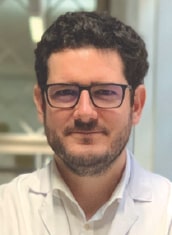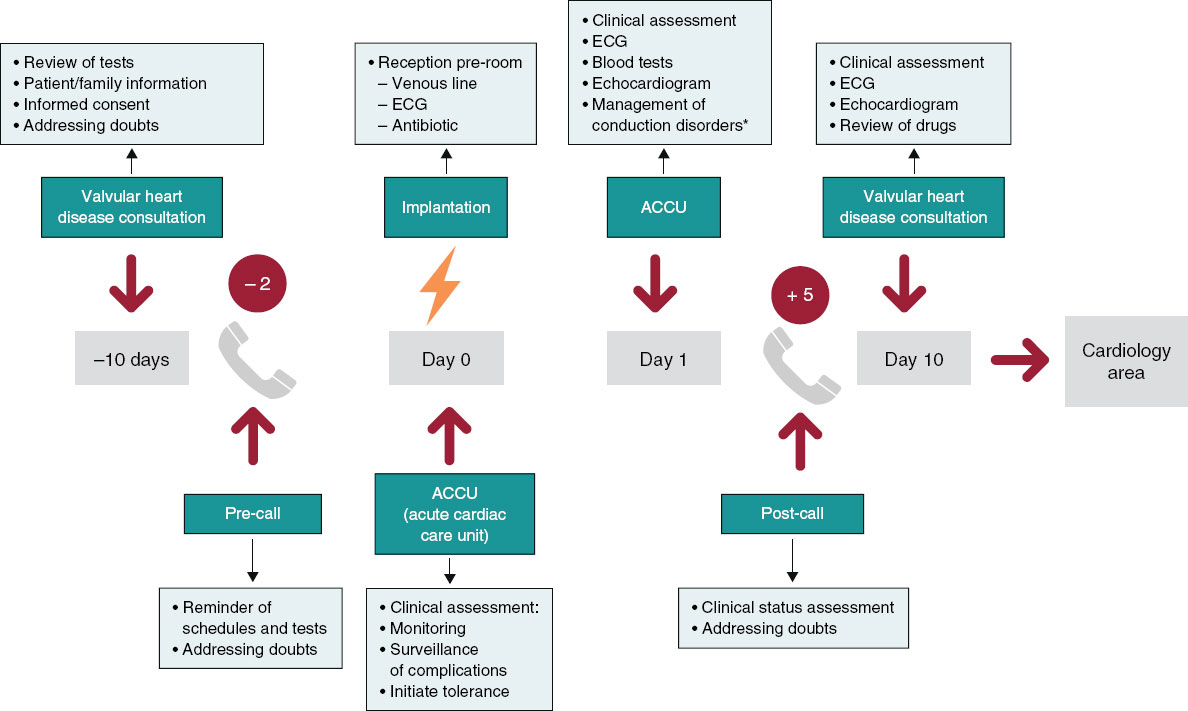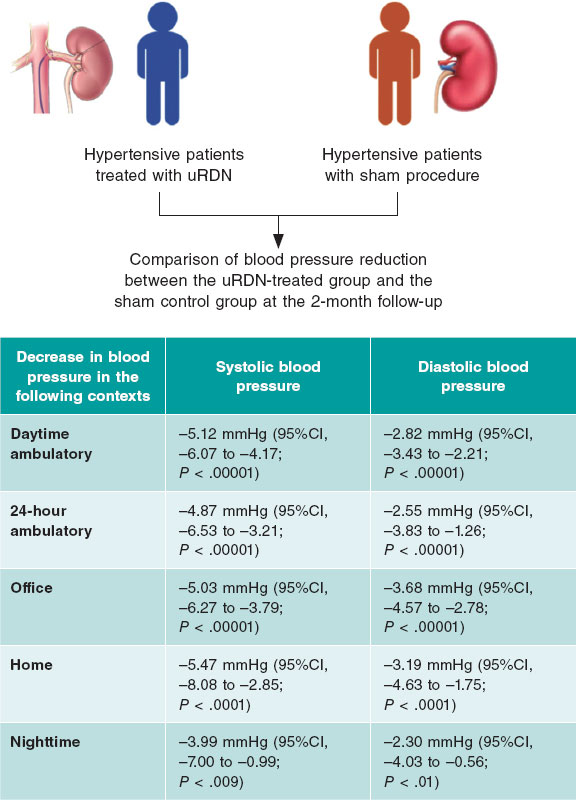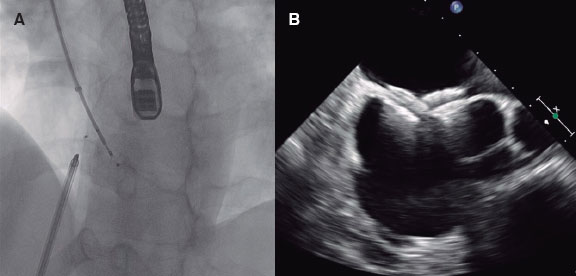QUESTION: What is the current status of percutaneous coronary interventions to treat functional mitral regurgitation (MR)?
ANSWER: Functional MR is one of the clinical conditions within cardiology that have experienced more changes over the last few years. Currently, not only the best way to treat it is under study including contributions from percutaneous techniques, but also its very definition is under review. Initially, cut-off values used to be selected to define its severity that were different from those of primary MR based on the results from longitudinal studies in populations that had suffered myocardial infarctions.1 However, it has not been easy to confirm that by using these diagnostic thresholds, the therapeutic procedures yield consistent benefits.2,3 As a matter of fact, to this date, it is recommended to use the same criteria as with primary MR (effective regurgitant orifice area ≥ 0.4 cm2 and regurgitant volume ≥ 60 mL).
Another issue under discussion is whether the best therapeutic strategy is valve repair or replacement. Most clinical trials have studied the easiest repair strategy, that is, restrictive annuloplasty. It consists of annular remodeling with a rigid or semirigid annulus that is 1 or 2 sizes smaller than the patient’s valve (usually determined by the intertrigonal distance or the anterior leaflet surface area). Despite the criticism received for the methodology used in the repair group and the results obtained after the procedure, several clinical trials conducted in the United States have shown no clear benefits of mitral valve repair over mitral valve replacement. However, a lower rate of MR has been reported in the group treated with valves.4,5 Several authors suggest that this repair method is not the best one, especially if the etiology is ischemic and considering that myocardial damage and remodeling—the true culprit of valve disease—is often localized and highly variable.
My opinion is that this field has finally entered the adult age. It seems obvious that there is not an easy way to treat all patients. Also, that success depends on the right selection of patients and techniques including, in particular, the use of techniques for the subvalvular apparatus like repositioning or papillary muscle sling. Secondary MR is a ventricular disease; this is what we all say, but most surgeons and cardiologists still try to solve it by only acting on the valve alone.
Q.: Which are the most suitable techniques today to repair mitral valves with organ failure?
A.: The best way to treat primary MR is surgical valve repair when possible. Such is the case of almost all patients with myxoid degeneration treated in experienced centers. Also, it is the therapy of choice to treat other etiologies such as endocarditis and rheumatic disease. However, the repair rate is lower and depends on lesions associated with the valve and in the remaining structures.
The association between primary MR repair and the experience of the treating center is well known.6 However, this experience is hard to gain; up to 50% of the patients who are eligible for valve repair keep are actually treated with valve replacements.7 This opens the debate of whether patients should follow specific patterns of referral to centers experienced on mitral valve repair to guarantee optimal results, especially young patients and during the early stages of disease (asymptomatic, in sinus rhythm, and with a normal left ventricle) as the current clinical practice guidelines recommend.8,9
Q.: Are there good surgical options to treat mitral annular calcification?
A.: Annular calcification is relatively common in rheumatic disease and in advanced cases of myxoid degeneration and, in general, does not pose a significant problem. However, a minority of patients show very extensive calcification of the valvular annulus with deep infiltration and spread towards the ventricular myocardial tissue. These cases pose a problem not easy to solve. Incomplete annular decalcification leads to fewer chances of achieving successful repairs and a higher risk of suboptimal results regardless of the technique used: associated residual MR and stenosis in the case of mitral repair or paravalvular leaks and insufficient valvular size in valvular replacement.
The solution to this problem is performing extensive decalcification, which is a complex procedure with associated risks. It often involves the aggressive debridement of the posterior atrioventricular sulcus and further reconstruction with some type of reinforcement material (autologous or heterologous pericardium or synthetic tissues like Dacron). This type of reconstruction requires the proper selection of patients and a very precise technique since its main complication—the tear of the posterior sulcus—is associated with high morbidity and mortality rates.
An interesting option recently presented although with scarce information on the mid-term results is a combination of a minimally invasive approach to prepare the valve followed by implantation under direct vision of an expandable valve, which optimizes valve fixation and avoids left ventricular outflow tract obstruction.
Q.: What is your opinion on less invasive surgical techniques to treat MR?
A.: I think that today they are the method of choice to surgically treat mitral valves because the benefits are obvious. We recently published our own experience on the management of mitral prolapse with a successful repair rate (98%) and a perioperative mortality rate < 1% in Revista Española de Cardiología.10 Minimally invasive thoracoscopic surgery was our preferred approach (more than 70% of the cases over the last few years) and is associated with less need for mechanical ventilation, shorter ICU stays, less blood loss, and less need for valve replacement at the 5-year follow-up (100% vs 95%).
Back in November 2019 we started our own robotic surgery program, the only one in Spain, with the Da Vinci system (Intuitive Surgical, United States), which basically focuses on mitral repair. By the time we were writing these lines, we had already treated 50 patients with very satisfactory results. In our early experience we think that the procedure is even less aggressive than thoracoscopy and is associated with further reductions of postoperative stays (median, 4 days).
There is no doubt in my mind that these minimally invasive techniques will keep growing and refining, and more patients will end up benefiting from repair surgeries less aggressively and with faster recovery times. Over the next few years, new robotic surgical platforms will be born for clinical use. Also, there will be new options for transapical neochord implantation without extracorporeal circulation. These advances will widen our current therapeutic armamentarium and join percutaneous techniques as part of our repertoire.
Q.: Tricuspid regurgitation (TR) is a complex condition of often unsatisfactory management. What does surgery have to offer these days and to who?
A.: TR has gradually been gaining the attention it deserves. One of the most important changes over the last few years is the confirmation of how important the early, prophylactic treatment actually is even when there is no left-sided valve disease when the procedure is performed.8,9 This adds to the recognition of the need to treat severe primary TR in isolation in patients with symptoms of right-sided heart failure and in asymptomatic patients with progressive right ventricular deterioration.9
Same as it happens with secondary MR, the management of functional TR requires understanding right ventricular remodeling and other associated nonvalvular lesions. Secondary TR has been treated with surgery too often and in a superficial way without the same level of attention and detail paid to left-sided valve disease. Same as it happens with mitral valve repair, the management of secondary TR requires a high level of training and experience. The results of valve repair are excellent in the landmark centers, and sometimes the use of additional techniques is required on the leaflets (anterior leaflet repair with patch augmentation), the subvalvular apparatus (papillary muscle repositioning, chordal shortening or transposition or neochordal implantation), the right ventricle (free-wall and annular plication), and the right atrium. These less traditional techniques allow us to bring the benefits of repair to cases of very advanced functional TR, primary etiologies and, in the case of secondary TR, to repair the damage caused by device wiring or thoracic traumas. A good example of these more complex and advanced procedures is the Da Silva’s cone repair technique in adult patients with Ebstein’s anomaly.11
Isolated tricuspid valve or concomitant to mitral surgery can also be treated through minimally invasive and robotic thoracoscopic surgery in experienced centers in most of the patients. The concomitant ablation of atrial fibrillation can follow too.
Q.: What does the future of interventional cardiology have in store with respect to heart surgery? Where should we look into from one specialty and the other?
A.: I personally see a bright future ahead for the patients (which is the most important thing of all), cardiovascular surgeons, and interventional cardiologists. The magnitude of these improvements and how fast they will spread out will depend on our capacity to acquire the necessary knowledge and skills to coordinate ourselves and collaborate with one another.
My opinion is that surgery needs to move towards perfecting training regarding valvular repair and minimally invasive techniques so that more patients can benefit from the better options available. The current low rates of valve repair in the management of mitral valve disease simply cannot stand. Together with cardiology we need to reflect on the current patterns of patient referral and look for formulas so patients can be operated on (whether surgically or percutaneously) in experienced centers. Also, patients need to gain access to all therapeutic options, and all the techniques available should be performed with optimal results based on scientific evidence, auditing, and the public disclosure of results.
FUNDING
None whatsoever.
CONFLICTS OF INTEREST
D. Pereda is a proctor for minimally invasive surgery for Edwards Lifesciences.
REFERENCES
1. Grigioni F, Enriquez-Sarano M, Zehr KJ, Bailey KR, Tajik AJ. Ischemic mitral regurgitation:long-term outcome and prognostic implications with quantitative Doppler assessment. Circulation. 2001;103:1759-1764.
2. Michler RE, Smith PK, Parides MK, et al. Two-year outcomes of surgical treatment of moderate ischemic mitral regurgitation. N Engl J Med. 2016;374:1932-1941.
3. Smith PK, Puskas JD, Ascheim DD, et al. Surgical treatment of moderate ischemic mitral regurgitation. N Engl J Med. 2014;371:2178-2188.
4. Acker MA, Parides MK, Perrault LP, et al. Mitral-valve repair versus replacement for severe ischemic mitral regurgitation. N Engl J Med. 2014;370:23-32.
5. Goldstein D, Moskowitz AJ, Gelijns AC, et al. Two-year outcomes of surgical treatment of severe ischemic mitral regurgitation. N Engl J Med. 2016;374:344-353.
6. Anyanwu AC, Bridgewater B, Adams DH. The lottery of mitral valve repair surgery. Heart. 2010;96:1964-1967.
7. Iung B, Baron G, Butchart EG, et al. A prospective survey of patients with valvular heart disease in Europe:The Euro Heart Survey on Valvular Heart Disease. Eur Heart J. 2003;24:1231-1243.
8. Baumgartner H, Falk V, Bax JJ, et al. 2017 ESC/EACTS Guidelines for the management of valvular heart disease. Eur Heart J. 2017;38:2739-2791.
9. Otto CM, Nishimura RA, Bonow RO, et al. 2020 ACC/AHA Guideline for the Management of Patients With Valvular Heart Disease:A Report of the American College of Cardiology/American Heart Association Joint Committee on Clinical Practice Guidelines. Circulation. 2021;143:e72-e227.
10. Ascaso M, Sandoval E, Quintana E, Vidal B, CastellàM, Pereda D. Early and mid-term outcomes of mitral repair due to leaflet prolapse in a national referral center. Rev Esp Cardiol. 2021;74:462-4.
11. Fernández-Cisneros A, Ascaso M, Sandoval E, Pereda D. Cone repair for Ebstein's anomaly and atrial fibrillation ablation in an adult patient. Multimed Man Cardiothorac Surg. 2020. http://dx.doi.org/10.1510/mmcts.2020.064.
* Corresponding author: Cirugía Cardiovascular, Hospital Clínic, Villarroel 170, 08036 Barcelona, Spain.
E-mail address: dpereda@clinic.cat (D. Pereda).











